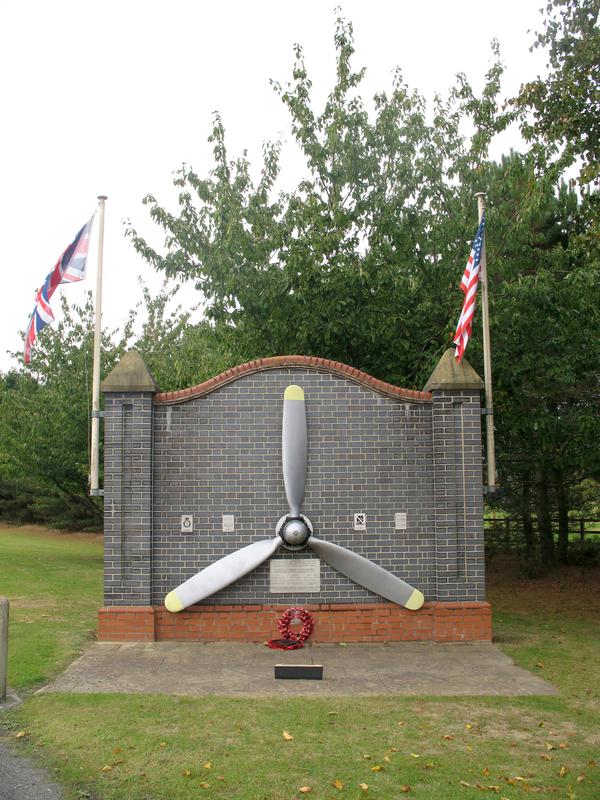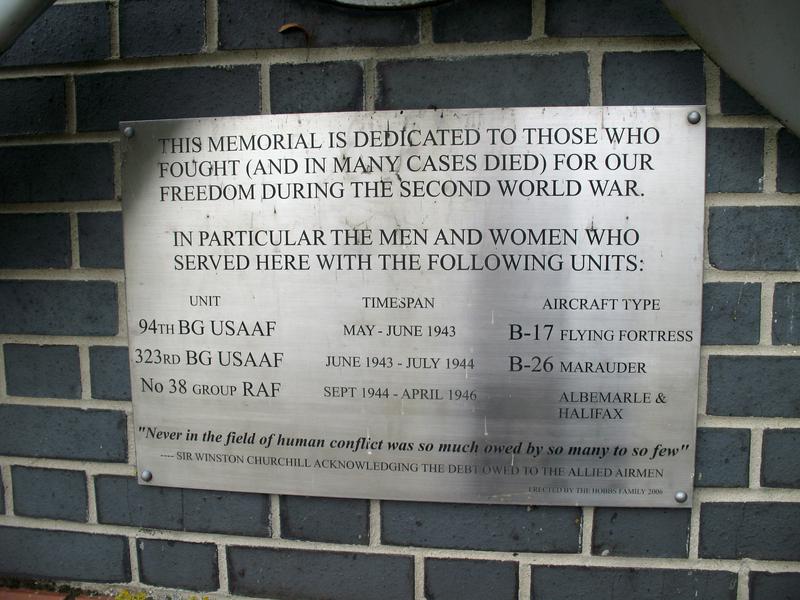RAF Earls Colne Monument
Details:
On the north side of the road.
A propellor from a B-17 Flying Fortress mounted on a decorative panel of blue and red bricks. Below it is a rectangular metal plaque with the inscription in English in incised and black lettering. Four small metal plaques with supporting information are placed on either side of the propellor. Two flagpoles with the Union Flag and the Flag of the USA are mounted onto the ends of the wall.
The first American unit to use Earls Colne was the 94th Bombardment Group (Heavy) moved in with the Boeing B-17 Flying Fortress, arriving from RAF Bassingbourn on 12 May 1943. The group tail code was a "Square-A". Its operational squadrons were:
- 331st Bombardment Squadron (BG)
- 332d Bombardment Squadron (OE)
- 333d Bombardment Squadron (ET)
- 410th Bombardment Squadron (QW)
Its tenure was brief as the Eighth Air Force moved the B-17s into Suffolk on 12 June as the group was moved to RAF Bury St. Edmunds in a general exchange of bases with B-26 Marauder groups.
Replacing the 94th at Earls Colne was the 323d Bombardment Group (Medium) which arrived from RAF Horham on 14 June 1943. The group was assigned to the 3d Bomb Wing and flew Martin B-26B/C Marauders with a Horizontal white tail band for its group marking. Operational squadrons of the 323d were:
- 453d Bombardment Squadron (VT)
- 454th Bombardment Squadron (RJ)
- 455th Bombardment Squadron (YU)
- 456th Bombardment Squadron (WT)
The 323rd inaugurated medium-altitude bombing missions on 16 July 1943. In common with other Marauder units of the 3d Bomb Wing, the 323d was transferred to Ninth Air Force on 16 October 1943. Tactical missions were flown against V-weapon sites along the coast of France and attacked airfields at Leeuwarden and Venlo in conjunction with the Allied campaign against the German Air Force and aircraft industry during Big Week, 20–25 February 1944. On 21 July the group was moved south to RAF Beaulieu in Hampshire, a move designed to extend their range over western France.
In September 1944 the airfield returned to RAF control, with No. 38 Group RAF bomber station operating the Armstrong Whitworth Albemarles and Handley Page Halifaxes. 38 Group was used as a glider towing unit (Squadrons Nos. 296 and 297). Both squadrons participated in Operation Varsity, the airborne part of the Rhine Crossing in March 1945.
Source of information: www.warmemorialsonline.org.uk, Imperial War Museum War Memorials Register, military.wikia.org
Source of photos: Imperial War Museum War Memorials Register
Monument Text:
THIS MEMORIAL IS DEDICATED TO THOSE WHO
FOUGHT (AND IN MANY CASES DIED) FOR OUR
FREEDOM DURING THE SECOND WORLD WAR.
IN PARTICULAR THE MEN AND WOMEN WHO
SERVED HERE WITH THE FOLLOWING UNITS:
|
UNIT 94TH BG USAAF 323RD BG USAAF NO 38 GROUP RAF |
TIMESPAN MAY - JUNE 1943 JUNE 1943 - JULY 1944 SEPT 1944 - APRIL 1946 |
AIRCRAFT TYPE B-17 FLYING FORTRESS B-26 MARAUDER ALBEMARLE & HALIFAX |
"Never in the field of human conflict was so much owed by so many to so few"
--- SIR WINSTON CHURCHILL ACKNOWLEDGING THE DEBT OWED TO ALLIED
ERECTED BY THE HOBBS FAMILY 2006
Commemorates:
Units:
323rd Bomb Group
8th Air Force
94th Bomber Group, Heavy
9th Air Force
US Army Air Corps
Wars:
WWII
Other images :


